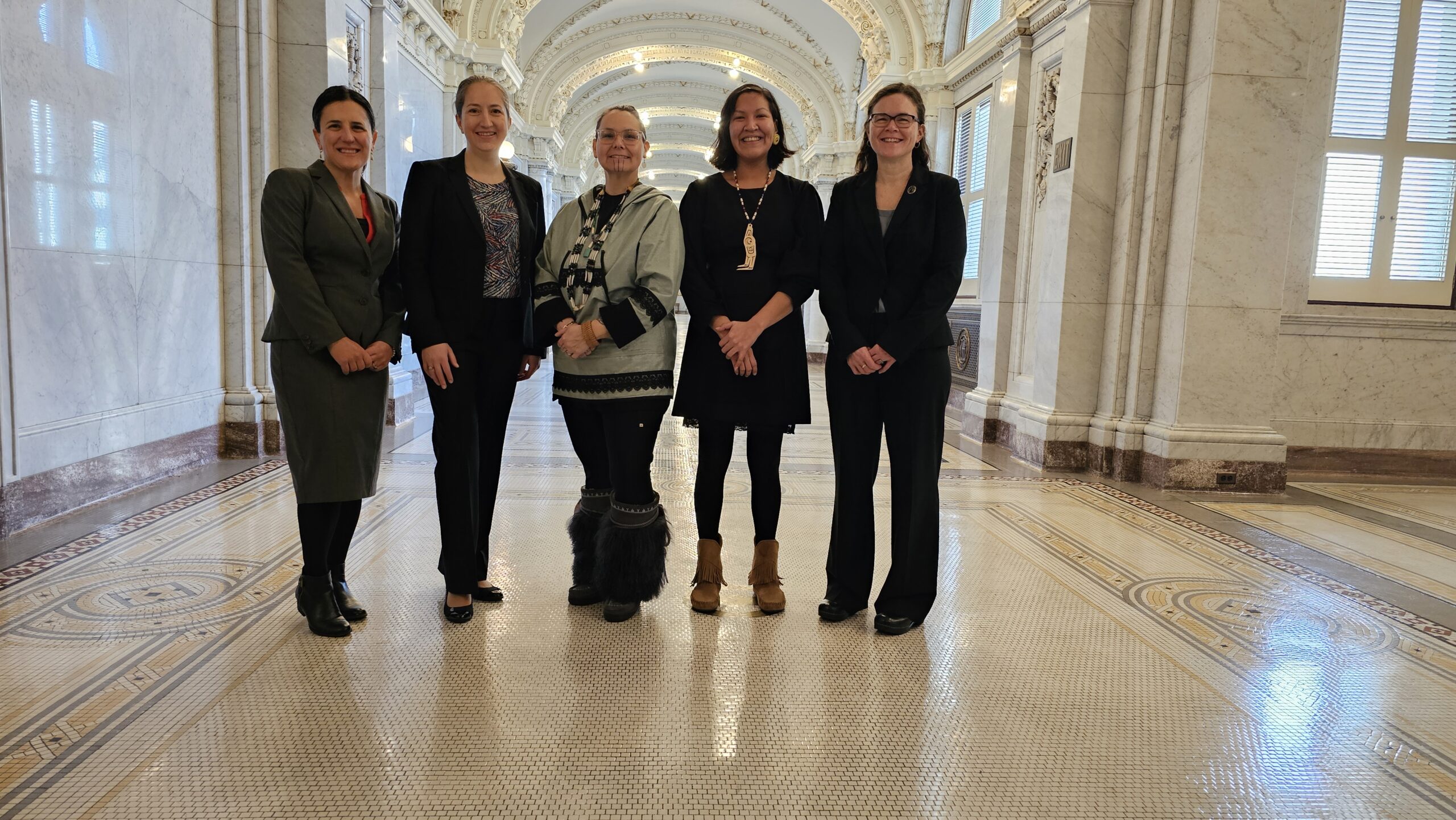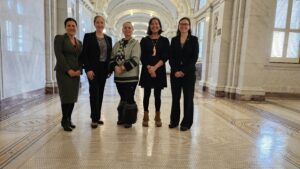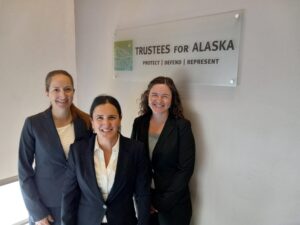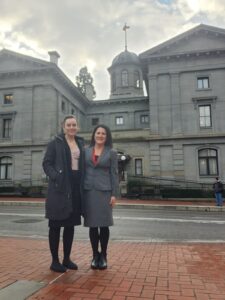
Getting in the zone and what’s next on Willow and regulations allowing harassment of polar bears
By Dawnell Smith
What does a prepared and practiced attorney look like during oral argument? They know page numbers and case names. They use subtly emphatic hand gestures. They answer judges’ questions while steering back to their main points. They appear calm, seamless, focused.

At the Willow appeal in the 9th Circuit Court on Feb. 5, 2024. From the left: senior staff attorneys Bridget Psarianos and Suzanne Bostrom; Roo Ramos and Wasabi (Sharla Hausmann) from SILA, and Brook Brisson, senior staff attorney and Arctic team lead.
Oral argument may only involve 15 to 20 minutes of presentation to the court, but a lot of hard work goes into making sure our attorneys are ready to field questions from the court and to focus on the most important issues. It takes practice and the full support of the entire legal team to prepare in the days and weeks leading up to the argument. It’s that practice and teamwork that gets our attorneys in the zone, on point, and able to be utterly present when they walk into the courtroom.
Earlier this month, two of our senior staff attorneys argued in the 9th U.S. Circuit Court of appeals. Suzanne Bostrom argued in our Willow lawsuit in San Francisco, with Bridget Psarianos and Brook Brisson as co-counsel; days later, Bridget argued in our Beaufort Sea incidental take regulation litigation, with Joanna Cahoon as co-counsel.
What happened and what’s next?
We filed our current Willow lawsuit in March 2023, which contends the Biden administration illegally approved the massive ConocoPhillips oil and gas project. A district court ruling allowed the project to push forward, so we appealed in the Ninth Circuit court.
Willow would expand ConocoPhillips’ extensive oil and gas extraction operation in the Arctic, becoming a hub for future industrialization. It would have dramatic impacts on local communities whose culture centers on caribou and subsistence practices, and it would spew toxic pollution and greenhouse gases. A recent study adds to the body of evidence and traditional knowledge showing that caribou are extremely sensitive to industry roads and that those roads could have significant impacts on community health.

Our Arctic legal team has worked on Willow for many years now. Here they are a few years ago after arguing in court to stop Willow: Suzanne Bostrom, senior staff attorney; Bridget Psarianos, senior staff attorney; and Brook Brisson, senior staff attorney and Arctic team lead.
One of our arguments in the case centers on how the government went into its analysis and decision-making process with a presumption that it needed to allow full-field development. In other words, the agency took the stance that because ConocoPhillips held leases, the government had to allow full development of all those leases. As a result of this erroneous interpretation, the agency declined to consider reasonable alternatives with a smaller scope of development, as it is required to do, and it curtailed how far it would go to reduce impacts to special areas like Teshekpuk Lake and subsistence use of these areas.
“The oil companies and corporations are saying only community outsiders don’t want this huge development,” said the advisory board of Sovereign Iñupiat for a Living Arctic in a statement provided during the oral argument. “We are a grassroots Indigenous and Elder-led organization, and we are asserting our existence and rights as affected community stakeholders. We stand together for Mother Earth, wildlife, and people that are already struggling from climate change-related impacts right now.”
Protecting vulnerable Beaufort Sea polar bears
A few days after the Willow argument, Bridget flew to Portland for a second 9th Circuit Court appearance, joined by attorney Joanna Cahoon. This time, the argument concerned a federal regulation that authorizes oil and gas operators to harass polar bears in the southern Beaufort Sea and nearshore North Slope area. These polar bears are already profoundly threatened by climate change.

Staff attorney Joanna Cahoon with Bridget at the 9th Circuit Court in Portland arguing against a regulation allowing oil operators to harass polar bears.
One point Bridget made during the argument is that this population of bears is truly vulnerable and even one bear or cub death goes against the intent of laws protecting these bears. For this reason, the U.S. Fish and Wildlife Service’s refusal to consider the 94 percent chance of at least one cub death was unlawful. She also emphasized that though the Service claims that a “small number” of bears would be impacted — “small numbers” being a legal constraint on the Service’s ability to issue such regulations — the fact remains that, over the five-year term of the regulation, half of this bear population is to be harassed.
Harassment refers to heavy equipment, aircraft, and a range of oil and gas activities disturbing bears in harmful ways, including triggering feeding bears to abandon food, forcing sows with cubs to leave dens, and scattering bears when they are interacting. The U.S. Fish and Wildlife Service’s regulations claim that the impact of oil activities may bother bears but do not cause serious harm, despite their own studies showing that operations over the next five years are essentially certain to injure or kill cubs.
We went to court in 2021 to challenge federal regulations allowing North Slope oil operators to harass polar bears. The district court ruled against us, and we appealed in April 2023.
Bridget describes preparing for and arguing a complex federal case like this as a marathon with a sprint at the end. “After spending years litigating these cases, you then need to try to memorize as much as you can about the details for 20 minutes of conversation with smart and well-prepared judges,” she said. “It’s very nerve-wracking, but the best way to calm my nerves is to feel like I’ve over-prepared. And to know that I have a tasty meal and nice drink to look forward to after the argument.”
Courts rule in their own time, but we hope to get rulings in the next few months on both appeals. In the meantime, our entire legal team will continue to sustain the level of research, knowledge-collection, practice, and preparation to put us in the zone for whatever happens next on all our lawsuits and issues.


